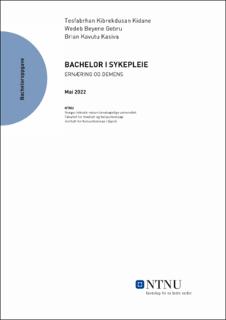| dc.contributor.advisor | ÅSLUND ANNE MARIT | |
| dc.contributor.author | KIDANE TESFABRHAN KIBREKDUSAN | |
| dc.contributor.author | GEBRU WEDEB BEYENE | |
| dc.contributor.author | KASIVA BRIAN KAVUTU | |
| dc.date.accessioned | 2022-07-13T17:19:10Z | |
| dc.date.available | 2022-07-13T17:19:10Z | |
| dc.date.issued | 2022 | |
| dc.identifier | no.ntnu:inspera:106262086:112059464 | |
| dc.identifier.uri | https://hdl.handle.net/11250/3005171 | |
| dc.description.abstract | Bakgrunn: Flere studier har vist at 80 % av pasientene som bor på sykehjem i Norge har demenssykdom. Forekomsten av underernæring hos disse gruppene er ofte høy. Det er fordi flere av pasientene med demens sliter med å få i seg nok mat på grunn av kognitiv svikt, fysisk svekkelse og nedsatt evne til å tolke sanseinntrykk. Oppgaven tar sikte på å besvare hvordan sykepleie kan forebygge underernæring hos disse pasientene.
Hensikt: Hensikten med den oppgaven er å øke kompetanse og kunnskap om ernæring hos pasienter med demens. Deretter å kunne forebygge underernæring hos disse pasientene.
Metode: I denne oppgaven har vi brukt litteraturstudie for å samle inn litteratur, og forskningsartikler for å belyse våre problemstillinger. Tre ulike databaser er benyttet for å finne forskningsartikler. Artiklene er analysert og funnene er tematisert.
Resultat: Forskningsstudier som ble inkludert for å besvare den oppgaven viser at demens pasientene som bor på sykehjem er utsatt av underernæring.
Grunnen er at personalet mangler kompetanse for å opprettholde ernæringsstatus. Det er fire hovedkategorier som er identifisert; økt kunnskap, tilrettelegging av spisemiljø, økt bemanning og identifisere individuelle faktorer.
Konklusjon: Identifisere risikofaktorer for underernæring, individuell ernæringsplan, oppfølging og evaluering er viktige tiltak for å forebygge underernæring hos disse pasientene. Ved tidlig vurdering av ernæringsstatusen og observasjon, kan sykepleier identifisere pasientene som er underernært eller i risiko for underernæring. Dermed kan sykepleier iverksette tidlig intervensjon. For å oppnå dette, må de øke oppmerksomheten, få økt bemanning og opplæring for helsepersonell. | |
| dc.description.abstract | Background: Several studies have shown that 80% of patients living in nursing homes in Norway have dementia. The incidence of malnutrition in these groups is often high. This is because several of the patients with dementia struggle to get enough food due to cognitive impairment, physical impairment and the ability to interpret sensory impressions. The thesis should answer how nursing can prevent malnutrition in these patients.
Amis: The purpose of this task is to increase competence and knowledge about nutrition in patients with dementia. Then can prevent malnutrition in these patients.
Method: This thesis we have used literature study to collect literature, and research articles to shed light on our issues. Three different databases have been used to find research articles. The articles have been analyses and the findings are titled.
Resultant: Research studies that were included to answer that question show that dementia patients who live in nursing homes are exposed to malnutrition. The reason is that the staff lacks the competence to maintain nutritional status. There are four main categories that have identified. Increased knowledge, facilitation of the dining environment, increased staffing and identifying individual factors.
Conclusion: Identifying risk factors for malnutrition, individual nutrition plan, follow-up and evaluation are important measures to prevent malnutrition in these patients. By early assessment of nutritional status and observation, nursing can identify patients who are malnourished or at risk of malnutrition. Thus, nursing can initiate early intervention. To achieve this, they need to increase awareness, increased staffing and training for health professionals. | |
| dc.language | nob | |
| dc.publisher | NTNU | |
| dc.title | ERNÆRING OG DEMENS | |
| dc.type | Bachelor thesis | |
